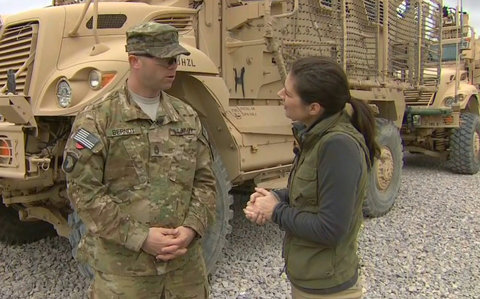 CNN Erin Burnett of CNN interviewed Army Sgt. First Class Josh Berndt in Afghanistan early this month.
CNN Erin Burnett of CNN interviewed Army Sgt. First Class Josh Berndt in Afghanistan early this month.
Look closely at the end-of-the-year lists of 2012’s top news stories. What’s missing? The 11-year-old war in Afghanistan and American-led counterterrorism efforts around the world.
The Pew Research Center’s weekly polling on the public’s interest in news stories showed such a low level of interest that the overseas conflicts didn’t make the organization’s list of the year’s top 15 stories.
Nor did the Afghan war come up often when The Associated Press conducted its annual poll of editors and news directors in the United States. The only overseas stories voted to be the year’s top news stories involved Libya and Syria.
Yahoo’s list of the top news stories of the year also omitted the war, and so did a separate list of the top international news stories. Those lists were created by analyzing millions of searches by Yahoo users.
The absence of words like “Afghanistan” from year-end lists reflects both the national news media’s scant coverage of the war and the public’s disengagement with it.
“We are in a period where the American public is intensely focused on domestic economic concerns,” said Michael Dimock, the associate director for research at the Pew Research Center for the People and the Press. “On top of this, the public is having a hard time staying focused on foreign engagements that have been ongoing for over a decade.”
The exceptions to what he called this “war fatigue” are mass killings of Americans in the war zone, “which continue to draw public focus for short periods of time,” he said.
No such occurrence registered on the radar this year. Thus, Pew found that spikes in public interest were higher around events like the Summer Olympics and President Obama’s embrace of gay marriage than around anything to do with the war. There were no significant spikes in interest around the secret American campaign of drone strikes in Pakistan, Yemen and Somalia.
About 68,000 American troops remain in Afghanistan now that the troop surge ordered by the Obama administration in 2010 has ended. Combat troops are scheduled to leave the country by the end of 2014. For the time being the American presence is covered by a small band of reporters, predominantly in the country’s capital, Kabul.
Erin Burnett of CNN was one of the few American television anchors to take her nightly show to Afghanistan in 2012. She anchored from Kabul on Dec. 13 and told viewers that “America’s longest war is still not won.” Her reporting was cut short; the next day, the elementary school massacre in Newtown, Conn., pre-empted all other programming on CNN.
The Associated Press poll of editors had already taken place; it was redone a few days later, and the massacre was ranked the top story of the year.
Article source: http://mediadecoder.blogs.nytimes.com/2012/12/30/among-top-news-stories-a-war-is-missing/?partner=rss&emc=rss